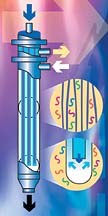
But the term has a broader application and can encompass reclaiming reusable energy sources.
The George Fischer Calorplast flexible-type heat exchanger has been designed to prevent solid buildup from fluids containing fibers or other particulates. It is said to work in any application where a fluid containing particulate matter needs to be heated or cooled.
According to the company, "Conventional heat exchangers are typically prone to fouling and plugging of the tubing with fluids containing dirt deposits, contamination, fibers, suspended solid material, and sedimentation.
"The Calorplast Flexible Heat Exchanger was developed to overcome these problems and at the same time provide an efficient means of reclaiming reusable energy sources."
The company noted the product uses a tube bundle with moveable heat transfer elements that connect to a special feed and return flow manifold only at one end. "The other end of the tubes are not connected and can move freely inside the chamber, preventing plugging or buildup of solids on the tube wall."
The company describes the technology this way:
"The ability of the elements to move freely enables the elements to adapt to the flow conditions, to evade large foreign bodies, and to effectively avoid clogging and dirt deposits.
"In view of their common occurrence and temperatures, effluent waste water constitutes a considerable reservoir of reusable energy."
The report noted that several flexible heat exchangers can be connected in cascade, parallel, or mixed cascade/parallel hybrid configurations. "The latter configuration is of particular interest in order to obtain equal process water and wastewater mass flow rates with high heat transfer performance.
"In many cases, waste water appears discontinuously and at times other than those of heat demand. With separate waste water circuit and heat storage device this problem is not only solved, but also the economic efficiency of the heat exchanger is considerably improved by optimum performance matching and longer circulating time. The waste water circulates through the flexible heat exchanger until temperature equilibrium between the waste water pit and the heat storage device is almost reached."
For more information, go to www.us.piping.georgefischer.com/direct/index.cfm?heatex.
Publication date: 03/01/2004


Report Abusive Comment